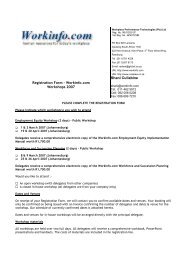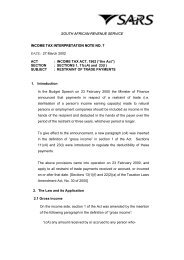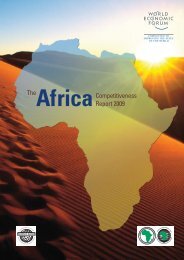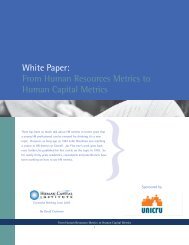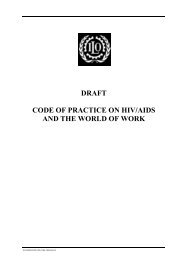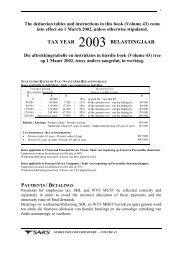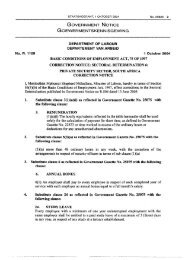The CEO's role in talent management - DDI
The CEO's role in talent management - DDI
The CEO's role in talent management - DDI
You also want an ePaper? Increase the reach of your titles
YUMPU automatically turns print PDFs into web optimized ePapers that Google loves.
PROFILES<br />
<strong>The</strong> CEO’s <strong>role</strong> <strong>in</strong> <strong>talent</strong> <strong>management</strong><br />
How top executives from ten countries are nurtur<strong>in</strong>g the leaders of tomorrow<br />
Executive: John Swa<strong>in</strong>son<br />
Chief Executive Officer and President<br />
Company: CA Inc.<br />
Location: Islandia, N.Y.<br />
CEO s<strong>in</strong>ce: 2004<br />
Age: 51<br />
Previous position: Vice-president of worldwide<br />
sales, IBM (Software Group)<br />
Sector: Technology<br />
Revenue (2005): US$3.5bn<br />
New chief executives may have to make big<br />
changes <strong>in</strong> how they develop executives and<br />
reta<strong>in</strong> them. This is a major challenge. When<br />
John Swa<strong>in</strong>son became CEO of CA Inc. <strong>in</strong> 2004,<br />
the company’s approach to <strong>talent</strong> <strong>management</strong><br />
was disjo<strong>in</strong>ted. Senior managers showed little<br />
<strong>in</strong>terest <strong>in</strong> develop<strong>in</strong>g subord<strong>in</strong>ates, rely<strong>in</strong>g<br />
more on outside recruiters to fill open<strong>in</strong>gs as the<br />
company grew. Human resources—not top<br />
executives—was <strong>in</strong> charge.<br />
As a result, the software company lacked<br />
potential replacements for a number of its top<br />
35 <strong>management</strong> positions. Mr Swa<strong>in</strong>son, a<br />
former IBM executive, says a company with<br />
more than 16,000 employees and 1,000<br />
executives should be able “to develop 15-20<br />
[senior] vice-presidents capable of lead<strong>in</strong>g the<br />
organisation. What there was was driven by HR,<br />
and from what I can tell, <strong>talent</strong> <strong>management</strong><br />
wasn’t taken terribly seriously by the former<br />
senior <strong>management</strong> team. <strong>The</strong>re just wasn’t a<br />
well of <strong>in</strong>side <strong>talent</strong>. Historically, the answer at<br />
CA [was], ‘We’ll hire somebody for that <strong>role</strong>.’<br />
That isn’t a very good answer.” He adds: “<strong>The</strong><br />
issue of organisational development wasn’t<br />
taken seriously until now. So there is a big gap<br />
which we are start<strong>in</strong>g to close.”<br />
Mr Swa<strong>in</strong>son believes this deficiency can be<br />
costly and underm<strong>in</strong>e long-term stability. “<strong>The</strong><br />
fact that people are prepared to move <strong>in</strong>to<br />
positions rapidly and can assume those<br />
positions is an important th<strong>in</strong>g,” he says. He<br />
adds that even a thorough recruit<strong>in</strong>g process<br />
may not ensure that the right person is<br />
recruited. “No matter how good your due<br />
diligence is, you can never be sure that the<br />
person you are hir<strong>in</strong>g really is well suited for the<br />
job,” he says. “You may get somebody onboard<br />
and discover that they are not really as good as<br />
you thought. That can stra<strong>in</strong> growth. In a<br />
bus<strong>in</strong>ess like ours, there is such an <strong>in</strong>credible<br />
<strong>in</strong>terdependency that the lack of an effective<br />
leader <strong>in</strong> one part of the organisation can<br />
actually stra<strong>in</strong> another.”<br />
But CA was <strong>in</strong> a period of transition and<br />
faced other challenges. An <strong>in</strong>vestigation by the<br />
Security and Exchange Commission led to the<br />
resignation of the company’s former CFO <strong>in</strong><br />
2003 and other senior executives. A year later,<br />
CA agreed to pay shareholders US$225m to<br />
avoid crim<strong>in</strong>al prosecution. Shortly afterwards,<br />
the company’s former CEO and another senior<br />
executive were <strong>in</strong>dicted for security fraud,<br />
conspiracy and obstruction of justice.<br />
Mr Swa<strong>in</strong>son spent much of his first year<br />
focus<strong>in</strong>g on operational issues, such as<br />
revamp<strong>in</strong>g the firm’s account<strong>in</strong>g system.<br />
However, over the past six months, he has been<br />
focus<strong>in</strong>g more on personnel strategy. In a series<br />
of meet<strong>in</strong>gs with his <strong>in</strong>ner circle of about 35<br />
senior managers, he began last September to<br />
identify future leaders and discuss how to<br />
prepare them through tra<strong>in</strong><strong>in</strong>g and job<br />
“In a bus<strong>in</strong>ess like ours, there is such an<br />
<strong>in</strong>credible <strong>in</strong>terdependency that the lack of<br />
an effective leader <strong>in</strong> one part of the<br />
organisation can actually stra<strong>in</strong> another.”<br />
experience. He subsequently presented his<br />
f<strong>in</strong>d<strong>in</strong>gs to CA’s board of directors. Mr Swa<strong>in</strong>son<br />
reviews CA’s current succession plan for its top<br />
executives and plans one-to-two years and<br />
three-to-five years <strong>in</strong>to the future.<br />
Mr Swa<strong>in</strong>son spends 5-10% of his time on<br />
<strong>talent</strong> <strong>management</strong>, but he plans to <strong>in</strong>crease<br />
this level. He sees <strong>talent</strong> <strong>management</strong> as his<br />
exclusive responsibility. He helped to assemble<br />
CA’s present <strong>management</strong> team and has<br />
improved its succession plann<strong>in</strong>g. “We have<br />
created replacement tables that help us to<br />
design programmes that give people the skills<br />
and experience that they need to move up,” he<br />
says.<br />
Mr Swa<strong>in</strong>son covers leadership development<br />
and succession at quarterly bus<strong>in</strong>ess reviews<br />
with his top executives, quarterly conference<br />
calls with a wider circle of about 150 managers,<br />
retreats and other events. <strong>The</strong> meet<strong>in</strong>gs have a<br />
secondary purpose of <strong>in</strong>volv<strong>in</strong>g promis<strong>in</strong>g<br />
managers <strong>in</strong> important bus<strong>in</strong>ess decisions. Mr<br />
Swa<strong>in</strong>son sees his <strong>role</strong> as more strategic, while<br />
his COO supervises daily operations. Human<br />
resources is a source of ideas and ensures that<br />
the company executes its personnel strategies.<br />
“<strong>The</strong> HR guys are the facilitators,” he says.<br />
CA is <strong>in</strong> the process of creat<strong>in</strong>g a formal<br />
mentorship programme. But Mr Swa<strong>in</strong>son<br />
already mentors executives. Along these l<strong>in</strong>es,<br />
he assigns a vice-president from one of CA’s<br />
bus<strong>in</strong>ess units to a six- to n<strong>in</strong>e-month st<strong>in</strong>t <strong>in</strong> his<br />
office. <strong>The</strong> assignments give these executives a<br />
better overview of the organisation. <strong>The</strong><br />
company holds sem<strong>in</strong>ars and other <strong>talent</strong><br />
<strong>management</strong> events, where Mr Swa<strong>in</strong>son is a<br />
regular speaker. Among his favourite topics is<br />
what makes a great leader.<br />
CA uses executive coaches, although Mr<br />
Swa<strong>in</strong>son has personally found mentors to be<br />
more helpful dur<strong>in</strong>g his 28-year bus<strong>in</strong>ess career.<br />
He says that his <strong>in</strong>formal advisers taught him<br />
the importance of “clear, effective<br />
communication and common sense”. <strong>The</strong>se are,<br />
he says, “the two most important <strong>management</strong><br />
attributes. <strong>The</strong> only way you can be effective as<br />
a leader is to empower your leadership team<br />
and give them as much <strong>in</strong>formation as you can<br />
and as much of the thought process to deal with<br />
the <strong>in</strong>formation so that they will make decisions<br />
that are as good as one can make. My<br />
<strong>management</strong> philosophy is what I try to impart<br />
on my team. I try to get them to the po<strong>in</strong>t where<br />
they would make the same decision I would<br />
make if I was <strong>in</strong> that position. That entails<br />
gett<strong>in</strong>g them to th<strong>in</strong>k logically and clearly about<br />
the issue and gett<strong>in</strong>g them to ask questions, to<br />
probe for data and make sure that they really<br />
understand the situation.”<br />
Mr Swa<strong>in</strong>son believes a well-rounded<br />
background is the best preparation for CEO or<br />
COO, but with one caveat. He says that breadth<br />
alone is not sufficient; rather, candidates for<br />
these jobs should possess particular expertise <strong>in</strong><br />
one area and <strong>in</strong>-depth knowledge <strong>in</strong> key<br />
categories. “You have to be acknowledged as<br />
extraord<strong>in</strong>ary <strong>in</strong> what you do,” he says. “That<br />
comb<strong>in</strong>ed with breadth gives you the necessary<br />
prerequisites for the CEO job. <strong>The</strong> hardest part<br />
22 © <strong>The</strong> Economist Intelligence Unit 2006






